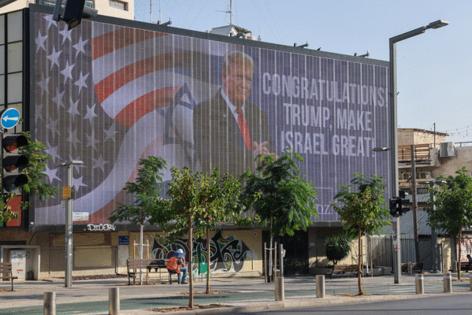Hal Brands: Iran is much weaker than the last time it faced Trump
Published in Op Eds
The Middle East has long been a source of misery for Washington. It could be a land of opportunity for Donald Trump.
In his first term as president, Trump brokered diplomatic détentes between Israel and several Arab states. In his second, he’ll encounter a region in which Israeli military successes have dramatically reset the balance of power. That creates the possibility for a bold play to roll back Iran’s influence and curb its nuclear program — if Trump can avoid stumbling into another Middle Eastern mess.
The regional situation has improved markedly from a year ago, when Israel looked shockingly vulnerable and Iran and its proxies seemed ascendant. Today, Israel hasn’t eliminated Hamas in Gaza, but it has wrecked most of its military capability. In Lebanon, Hezbollah can still fire rockets and conduct ambushes, but its leadership and long-range capabilities have been ravaged by Israeli assaults.
With U.S. help, Israel blunted Iranian missile and drone attacks in April and October, and delivered a damaging, targeted retaliation after the latter assault. With its proxies battered, its air defenses shredded and its missile arsenal devalued, Iran is more strategically naked than at any time in decades.
President Joe Biden deserves some credit here. Yes, Biden has often urged caution on Israel and his relationship with Prime Minister Benjamin Netanyahu is toxic. Still, Biden has given Israel the arms, the diplomatic assistance and the time necessary to take the offensive. The idea that Israel defends itself by itself is a myth: Several times, U.S. forces have even fought directly on its behalf (by shooting down drones and missiles). Since the Hamas invasion on Oct. 7, 2023, U.S.-Israel relations have been both deeply dysfunctional and devastatingly effective. What will Trump make of this inheritance?
He appears to have forgiven Netanyahu for acknowledging Biden’s victory in 2020; he surely admires Israel’s recent shows of strength. That provides an opening — and reports that Iran allegedly tried to assassinate Trump this fall provides extra motive — to further reset the region by squeezing its most malevolent regime.
Trump will likely renew his “maximum pressure” campaign to starve Iran of resources. The U.S. might simultaneously take sharper military action against Yemen’s Houthis, still wreaking havoc on Red Sea shipping.
The U.S. could also make clear that, along with Israel, it will hold Iran directly responsible for proxy attacks — a precedent Trump set by killing General Qassem Soleimani in 2020 — rather than giving Tehran strategic immunity by responding only against the proxies themselves. And the U.S. might give Israel additional arms and intelligence for an attack on Iran’s nuclear facilities — perhaps even joining that attack itself — unless Tehran accepts a tougher nuclear deal than the one Trump exited in 2018.
Finally, expect Trump to pick up Biden’s push for a regional grand bargain — diplomatic normalization between Israel and Saudi Arabia, coupled with enhanced U.S. defense and technological ties to the Saudis — that would consolidate the anti-Iran coalition.
The temptation to make these moves will be strong, because success — reversing the two-decade expansion of Iranian influence and keeping Tehran from acquiring the world’s most dangerous weapons — would be so rewarding. Given that Iran, China, Russia and North Korea are cooperating more closely, weakening Tehran would also weaken this larger autocratic coalition. But as ever in the Middle East, don’t downplay the complications.
First, Trump must determine what he wants. In his first term, he never decided whether the goal was to change Iranian policy or change the Iranian regime. Given Tehran’s weakness, the former objective may now be feasible. The latter, probably, is not.
Second, Trump must bring ambivalent Gulf states onboard. Saudi Arabia and the United Arab Emirates loathe Iran but fear conflict in their backyard. Trump will have to prove that the U.S. won’t simply abandon them when tensions spiral, as he did when Iran attacked Saudi Arabian oil facilities in 2019.
Third, Washington must mind the oil markets. Pressing Iran means removing from global markets most of the 1.7 million barrels per day it exports. Unless Trump relaxes sanctions against the likes of Russia and Venezuela, he’ll have to expand domestic production while bringing the Saudis and their spare capacity along.
Fourth, Trump can’t avoid grappling with Gaza. Saudi Arabia won’t normalize ties with Israel until the war there ends (and, perhaps, Israel at least gestures at the creation of a Palestinian state). Trump may hope that stronger U.S. backing will end the war through Israeli victory. If that fails, Trump’s support for Israel and his desire to close a Saudi deal could be at odds. And if the Israeli government goes ahead with a far-right plan to formally annex the West Bank, the regional diplomatic climate will change for the worse.
Finally, the risk of escalation is real. Iran is weak but not impotent. It won’t sit passively as Washington crushes its economy and Israel bludgeons its allies. Iran could respond by lobbing more missiles at Israel, targeting U.S. allies or military bases in the Persian Gulf, or perhaps even making a break for the nuclear bomb. Any of these moves could trigger the big, ugly war Trump aims to avoid.
The Middle East has changed, but it’s still the Middle East — where the most ambitious plans so easily go awry.
____
This column does not necessarily reflect the opinion of the editorial board or Bloomberg LP and its owners.
Hal Brands is a Bloomberg Opinion columnist and the Henry Kissinger Distinguished Professor at Johns Hopkins University’s School of Advanced International Studies.
©2024 Bloomberg L.P. Visit bloomberg.com/opinion. Distributed by Tribune Content Agency, LLC.




























































Comments